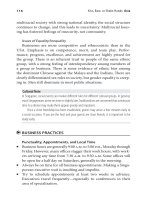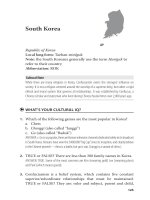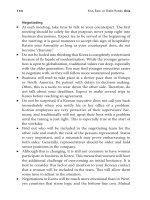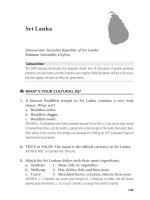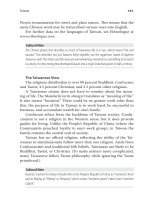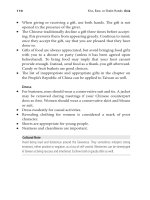How to run a GREAT hotel everything you need to achieve excellence in the hotel industry
Bạn đang xem bản rút gọn của tài liệu. Xem và tải ngay bản đầy đủ của tài liệu tại đây (2.21 MB, 272 trang )
HOW TO RUN A
GREAT
HOTEL
The publication of How to Run a Great Hotel is most timely for it addresses the key aspects of management,
and provides simple and easily implemented responses to assist today’s hotelier. With an emphasis on
excellence and best practice, Enda Larkin guides the reader through the book by focusing on key
messages presented in an uncomplicated and readily absorbed style. Using the themes of professional
development, leadership, change management and service quality, the author identifies those aspects of
the hotelier’s role where small changes in management approach can reap disproportionately high
rewards. This is vital, for of all the challenges facing the hotel industry, the availability of competent and
dedicated people remains by far the greatest.
Philippe Rossiter MBA FIH FTS, Chief Executive, Institute of Hospitality
How to Run A Great Hotel is a must in the hotel industry. Whether you are an experienced manager or
just starting a career and focusing on achieving excellence, then this book is your guide to success. I
strongly recommend it.
João Eça Pinheiro, Managing Director, Prainhamar Hotel Group, Portugal
How to Run a Great Hotel is the first hotel management book I have read that is actually practical, realistic,
informative and cuts through the waffle of ‘management mumbo jumbo’ which allows you to do exactly
what it says on the tin – help you run a great hotel.
Adriaan Bartels, MSc. Hosp. Mgmt, General Manager, Cliff House Hotel, Waterford, Ireland
It is fascinating how Enda Larkin simply breaks down the theoretical background of management theories
into practical advice in How to Run a Great Hotel. It is not only the easy description of some complicated
management theories but also the implementation in clear charts and very useful forms that makes the
book into a kind of bible for every hotelier that wants to be successful. It is this easy to understand
language and the translation into practical tips that makes the book so useful in daily life, even for the
very experienced hotelier.
Beat Wicki, CEO, SSTH Swiss School of Tourism and Hospitality Ltd
How to Run a Great Hotel is a wonderful exploration of strategy, leadership skills, and engaging employees
with a strong customer focus to achieve excellence in the hotel industry. Excellence principles tied
together by rich personal experiences make it an interesting, powerful and an easy to read format. The
publication is practical, with a how-to focus, and includes toolkits which can be used by practitioners
and trainers in the field. It is a great text for those interested in achieving excellence in hospitality
management and for those who want to experience what leadership and excellence in great hotels is really
like.
Kai Partale M.Sc, Partner, Success Consult Germany, experts in tourism and hospitality development and management
In this book Enda Larkin puts people at the centre of success for hotel investors and operators –
including leadership development, team coaching and customer relationship management. Industry
leaders, hotel developers, hotel general managers, asset managers and brand owners will all benefit by
reading the book and pondering its recommendations as relates to their particular area of interest and
involvement.
Ian Graham, Principal, The Hotel Solutions Partnership Ltd
This book should be on the desk of every Hotel Manager. Should we search for excellence in the hotel
industry? Should we seek to become a leader in the industry? We will feel much more confident making
these decisions after reading this book. To help us as we review or develop our hotel business plan, Enda
Larkin has included a section with practical steps towards excellence. I feel very fortunate to have learned
from his many years of experience and insights.
Khaled Alduais, Dean, National Hotel and Tourism Institute (NAHOTI) Sana’a – Yemen
HOW TO RUN A
GREAT
HOTEL
EVERYTHING YOU NEED TO
ACHIEVE EXCELLENCE
IN THE HOTEL INDUSTRY
EN DA M LARKIN
howtobooks
Published by How To Content,
A division of How To Books Ltd,
Spring Hill House, Spring Hill Road,
Begbroke, Oxford, OX5 1RX, United Kingdom
Tel: (01865) 375794. Fax: (01865) 379162
info_howtobooks.co.uk
www.howtobooks.co.uk
How To Books greatly reduce the carbon footprint of their books by sourcing their
typesetting and printing in the UK.
All rights reserved. No part of this work may be reproduced or stored in an information
retrieval system (other than for the purposes of review), without the express permission of
the publisher in writing.
The right of Enda Larkin to be identified as author of this work has been asserted by him
in accordance with the Copyright, Designs and Patents Act 1988.
© 2009 Enda Larkin
First published in electronic form 2009
British Library Cataloguing in Publication Data
A catalogue record for this book is available from the British Library
ISBN: 978 1 84803 354 2
Produced for How To Books by Deer Park Productions, Tavistock
Typeset by TW Typesetting, Plymouth, Devon
NOTE: The material contained in this book is set out in good faith for general guidance
and no liability can be accepted for loss or expense incurred as a result of relying in
particular circumstances on statements made in this book. Laws and regulations may be
complex and liable to change, and readers should check the current position with the
relevant authorities before making personal arrangements.
Contents
Acknowledgements
Foreword
Preface
xi
xiii
xv
Introduction
Towards excellence
Think, do, review
xvii
xvii
xix
Theme 1 – Define Direction
1
Chapter 1 – What is a strategic map and how can it help you to
achieve excellence?
What does having a strategic map actually involve?
Elements of a strategic map
Dispelling the strategic myths
Considering the realities
Summary
5
6
8
9
10
11
Chapter 2 – How can you create a strategic map for your hotel?
Creating your strategic map
Where are we now?
Where do we want to be? Big picture thinking
Living your vision and mission
How will we get there?
From strategies to annual plans
Summary
12
12
13
16
21
25
28
33
Chapter 3 – How can you measure the impact of your strategic
map over time?
How will we know we are getting there?
Define the results you want to achieve
Take action to achieve the results you want
Consider how you will measure progress
34
34
35
36
37
v
HOW
TO RUN A GREAT HOTEL
Measure progress at defined intervals
Analyse the results and make improvements
Summary
40
40
41
Theme 2 – Lead to Succeed
43
Chapter 4 – What does leading people actually involve?
Balancing the human equation
What’s the difference between leading and managing?
Leaders are different, but still human
Summary
47
48
49
51
52
Chapter 5 – How can you improve leadership effectiveness at
your hotel?
Here’s what not to do . . .
Creating a context for leadership at the hotel
Defining a leadership competence model
Improving individual and collective leadership performance
What makes a great leader?
Core leadership competences
Mastering the art of communication
Leading with style
Summary
53
53
54
56
56
57
63
64
70
74
Chapter 6 – How can you measure leadership effectiveness over time? 75
Continually improving leadership effectiveness
75
Define the results you want to achieve
76
Take action to achieve the results you want
76
Consider how you will measure progress
78
Measure progress at defined intervals
81
Analyse the results and make improvements
82
Summary
82
Theme 3 – Engage Your Employees
83
Chapter 7 – What does engaging your employees actually involve?
The twelve factors of employee engagement
Leadership, leadership, leadership
The link between culture and engagement
87
87
89
89
vi
CONTENTS
The impact of team composition
Clarity facilitates engagement
Competence supports engagement
Engagement and cooperation are interdependent
Control and engagement are not enemies
Effective communication builds engagement
More challenged means more engaged
Conflict and engagement are linked
Compensation influences engagement
Change is a factor in engagement
Summary
90
91
91
92
93
94
94
95
95
96
96
Chapter 8 – What can you do to more fully engage your employees?
How does effective leadership help?
How can you impact the culture in your hotel?
How can you manage the composition of your team?
How can you provide clarity for your employees?
How can you build the competence of your employees?
What can you do to increase cooperation between employees?
How can you address the control issue?
What can you do to improve communication at the hotel?
How can you make work more challenging?
How can you ensure that conflict doesn’t affect engagement?
How can you address the compensation issue to raise engagement levels?
How can you manage change to increase engagement?
Summary
98
99
100
104
110
112
115
116
117
120
121
122
124
125
Chapter 9 – How can you measure employee engagement levels
over time?
Measuring employee engagement levels
Define the results you want to achieve
Take action to achieve the results you want
Consider how you will measure progress
Measure progress at defined intervals
Analyse the results and make improvements
Summary
126
126
127
128
128
130
131
131
vii
HOW
TO RUN A GREAT HOTEL
Theme 4 – Captivate Your Customers
133
Chapter 10 – What is ServicePlusOne and why is it important?
Going back to basics
Understanding the risk factor
What is ServicePlusOne (S;1)
Towards S;1
Summary
137
137
141
141
147
148
Chapter 11 – How can you attain ServicePlusOne at your hotel?
Laying the foundations for S;1
The challenge of the experience web
The route to achieving S;1
What are your customers’ common and specific expectations?
Building a better customer experience
Raising your game to reach S;1
Summary
149
149
151
152
153
156
165
167
Chapter 12 – How can you measure the impact of ServicePlusOne
over time?
Measuring the impact of S;1
Define the results you want to achieve
Take action to achieve the results you want
Consider how you will measure progress
Measure progress at defined intervals
Analyse the results and make improvements
Summary
168
168
169
171
171
176
177
177
Make It Happen
179
Introduction
Theme 1 – Define Direction
Key messages from Theme 1:
Moving forward with Theme 1 – Action Checklist
Reviewing progress under Theme 1 – Diagnostic
viii
180
181
181
183
185
CONTENTS
Theme 2 – Lead to Succeed
Key messages from Theme 2:
Moving forward with Theme 2 – Action Checklist
Reviewing progress under Theme 2 – Diagnostic
187
187
189
191
Theme 3 – Engage Your Employees
Key messages from Theme 3:
Moving forward with Theme 3 – Action Checklist
Reviewing progress under Theme 3 – Diagnostic
193
193
195
197
Theme 4 – Captivate Your Customers
Key messages from Theme 4:
Moving forward with Theme 4 – Action Checklist
Reviewing progress under Theme 4 – Diagnostic
199
199
201
203
Looking ahead
205
Tools and Resources
207
Tools and Resources
Theme 1 – Planning Template
Theme 2 – Leadership Profile Self-Assessment
Theme 2 – Communication Skills Self-Assessment
Theme 2 – Leadership Style Self-Assessment
Theme 3 – Suggested Interview Plan
Theme 3 – Sample Interview Evaluation Form
Theme 3 – Suggested Format for an Appraisal Discussion
Theme 3 – Sample Employee Appraisal Criteria and Evaluation Form
Theme 3 – Suggested Structure for an Effective Meeting
Theme 3 – Sample Ideas Generation Form
Theme 3 – Sample Employee Engagement Survey
Theme 4 – Common Customer Expectations Across the Experience
Web
Theme 4 – Sample Mystery Guest Survey Template
Theme 4 – Sample Criteria for Integrating into Customer Feedback
Surveys
Index
208
209
210
211
212
213
214
215
217
218
220
221
223
230
241
245
ix
This page intentionally left blank
Acknowledgements
This book would not have been possible without the contribution of a great many
people. Thanks to all the hoteliers who have knowingly and sometimes unwittingly
provided inspiration through their dedication and commitment to achieving
excellence in hospitality. Thanks to family and friends who supported me as I tried
to produce something which would be of value to industry professionals.
Particular mention goes to Dr Tony Lenehan for his constant willingness to share
his expertise and for all his help and support over the years. Thanks also to Denis
Tucker, Tom Conneely and Peter Hutcheson – true believers in excellence – for
their guidance. Finally, to Giles Lewis and Nikki Read at How to Books, thank you
for helping to bring this book to fruition.
xi
This page intentionally left blank
Foreword
I am delighted to provide the foreword for How to Run a Great Hotel which is a
timely publication and essential reading for hoteliers in these challenging days. As
the owner and CEO of the Schindlerhof Hotel in Nuremberg, Germany I have
always been passionate about excellence. But a business must be profitable too;
there can be no pleasure without growth, for growth is the very stuff of life for a
company. Our achievements at the hotel show that there is a direct and
measurable link between the levels of excellence and profitability.
Since 1984, when I founded the hotel as a 3* property, I have transformed it into
a highly profitable 4* hotel which is now the leading Seminar hotel in Germany
and one of the best small hotels in Europe. Over that time, we have won many
awards, including the EFQM European Quality Award in 1998 and the Best Place
to Work Award in 2009, to name just two. Despite what we have achieved, we
never stand still and are constantly searching for new mountains to climb.
When people ask why we continually seek these new challenges, I can only give
one reason: today we face fierce competition that demands the highest levels of
performance. Being as good as your competitors is simply not sufficient. Nor is
it enough just to be 2% better. Today we need a real 30% edge on the competition
in a number of areas if the public or the spoiled customer is to notice that this
guy has really got something. This has been my core philosophy and has guided
all our efforts at the hotel, serving as our inspiration to this day.
In his book, Enda Larkin emphasises the importance of striving for excellence as
the major driver of business growth and profitability. He helps new and
experienced hoteliers to more clearly understand what excellence means in
practice, why it is of essential interest today and what practical steps can be taken
to bring it alive in your business so that you truly out-perform your competitors.
He also describes how learning and innovation can become the life blood of your
hotel. All of this is presented in an easy to read format, with lots of helpful tools
and resources provided to guide you. The principles he covers are adaptable to
suit the needs of any hotel, for there is more than one route to excellence.
Success in business life is never accidental; you create your own destiny. It starts
with having a long-term vision for your hotel, supported by clear and measurable
goals. Short term planning that is only concerned with next year’s cash flow cannot
be your starting point. In my experience, you must set your goals so high that the
xiii
HOW
TO RUN A GREAT HOTEL
greatest effort is needed to reach them. After all, the greater the goal the less
competition you have to fear. Theme 1 of this book will help you to devise
appropriate goals for your hotel.
Little can be achieved on the journey to excellence without effective leadership.
But leaders alone can’t make the result happen; you must set the example and
inspire a motivated and thoroughly dedicated team. Then you must give your
employees the freedom and desire to act. In doing so, always make sure your
people enjoy what they do; have fun at work, because your customers will sense
the difference. Themes 2 and 3 in this book are devoted to issues such as
leadership and employee engagement and I suggest you take the necessary time to
consider your current approach in these areas.
If you want to reach your goals then everyone in your hotel must be committed
to what you do; the collective focus must always be on building a great service
experience. I cannot emphasise enough the importance of service design, because
nothing matters more than satisfied customers. The reward for these efforts is that
service quality is nearly impossible for your competitors to copy. You will find
some practical guidelines under Theme 4 to help you to create memorable
customer experiences.
I firmly believe that the limitations on achievement are not business size, or
location but the scale and ambition of your dreams. Today, an increasing number
of hoteliers recognise the need for excellence; this is undoubtedly a good
development, but at the same time it also serves to constantly raise the bar. As
levels of quality increase across the industry, hoteliers which fail to continuously
improve their offering will soon be overtaken and eventually left far behind. Only
the best hotels will prosper in the future.
I strongly recommend this book as it will undoubtedly be a useful resource as you
strive to run a great hotel.
Klaus Kobjoll
CEO and Proprietor
Schindlerhof Hotel
Nuremberg, Germany
April 2009
Klaus Kobjoll is CEO of the Schindlerhof Hotel in Nuremberg, Germany one of the top hotels in Europe. He is
a charismatic and motivating speaker and is in constant demand to speak at conferences around the world. His Glow
& Tingle seminar business has grown exponentially in recent years to the extent that Klaus currently conducts
approximately 180 seminars each year.
xiv
Preface
The search for excellence goes on and it continues to be a hot topic across the
business world, including in hotels. So too in education, health and science. Even
in sport and the arts, it’s all the rage. In fact, in every field, it’s all about excellence,
with models to describe it, magazines to promote it and shiny awards to recognise
it. There are even special centres for excellence today.
Yet, for all the hype, excellence remains an elusive concept; hard to explain, even
harder to achieve. What does it actually mean in a hotel context? How can it be
realised? What is it that makes a great hotel? It is questions such as these which lie
at the heart of this book. To begin with, excellence is as much about attitudes as it
is about actions. It means having a real desire to not only compete, but to lead.
Most hotel professionals have great hopes for their business and being the best is
usually high on their list of desires. But it’s easy to lose sight of that goal when faced
with the day-to-day challenges of hotel life. In a customer-driven environment, the
immediate can overshadow the important; doing rather than thinking can take
precedence. This goes some way to explaining why aspirations and achievements
don’t always match up when it comes to excellence. Simply wanting it isn’t enough.
Becoming a leader in any industry doesn’t just magically happen. Nor does it come
quickly, or indeed easily. The journey is a long and challenging one, but very
rewarding at the same time. The content here will serve to inform that journey,
focusing as it does on proven drivers of excellence such as strategy development, enhancing
leadership skills, engaging employees and attaining customer focus. Without clear direction in
these critical areas, excellence will only ever be an ideal and never a reality.
The guidance offered throughout this book is the culmination of my 20 years
spent managing and consulting in the hotel industry. It is based on first-hand
experience, interviews with successful hoteliers and countless observations of best
practices seen in great hotels, large and small, around the world.
For all experienced or aspiring hotel professionals this book offers no-nonsense
advice, presented in an easy-to-read format, which will make a lasting impact on
personal and business performance. It will serve as a welcome companion on the
journey to excellence.
xv
This page intentionally left blank
Introduction
You don’t need anyone to tell you just how competitive the hotel industry is; you are
probably all too aware of that fact. Of course, the exact nature of the competition you
face depends on factors such as your location and the markets you are in, but for sure,
you will be competing with others for your share of the spoils. This is a good thing,
even if it doesn’t always feel that way, because it forces you to stay on your toes.
The challenges in hotels are compounded by the fact that the industry is
particularly susceptible to economic volatility and other shocks which are beyond
our control. The current global recession is a good example of that instability. Add
to this mix an ever more savvy and demanding customer and it is clear that
our industry is as competitive as it gets. In such a dynamic environment, it is
not an exaggeration to say that only the very best hotels can prosper over the
long term.
It is for this reason that excellence is a paramount concern in our industry. It
matters everywhere and to everyone: from the small family-run operation to the
large hotel chain, at the budget and luxury ends of the market, in new or well
established hotels. Whether you own or manage a hotel, are early in your career
or have years of experience behind you, it’s an issue for you. Whatever your
particular circumstances, excellence matters because customers increasingly demand it and lasting success in our industry stems from an ability to deliver it.
Towards excellence
The path to excellence lies in taking a long-term view of business development
and involves constantly question what it is you are doing and why you are doing
it, with a view to continuously improving every aspect of your operation. Seeking
to achieve excellence requires a consistent focus on four central themes which are
regularly seen, not only in all great hotels, but in all leading businesses. These
themes are shown in the diagram overleaf.
It is these four themes which drive excellence and they will serve as the framework
for this book. Although there are many other factors which impact on the
operation of a successful hotel, mastering these themes is what helps to turn good
into great. Little attention is given here to specific functions such as marketing and
finance, not because they aren’t important, they are, but without constant attention
xvii
HOW
TO RUN A GREAT HOTEL
to these four critical areas you can’t excel, no matter how well you manage your
finances, or market your hotel.
Leading enterprises apply these themes by considering the following points.
❑ Clear Direction defining what excellence will mean in the business and
converting those broad aspirations into measurable goals, with related strategies
and plans designed to make them a reality.
❑ Effective Leadership leading the business with passion and energy and
harnessing the support of others in realising the defined goals.
❑ Engaged Employees genuinely treating employees as stakeholders in the
business and recognising that success is ultimately achieved through them.
❑ Captivated Customers moving beyond lip service to customers by placing
them firmly at the centre of everything you do.
The aim here is to explore these themes in a practical manner so that you can
apply them in a meaningful way at your hotel. The intention is not to prescribe
xviii
I NTRODUCTION
what you must do, but rather to give you guidance on what you might do. And
that’s the key, everything covered in this book can be tailored to meet your specific
needs – you will adapt, not adopt based on your own particular circumstances.
Think, Do, Review
Principles and practices of excellence are often made more complicated than they
need to be, so we will use a simple conceptual model to guide us as we explore
how to bring these themes alive in your hotel. Everything that happens, or should
happen within our four themes can be broken down into: Think, Do, Review.
In line with this model, the book contains four main sections – one for each
theme. Within each section, you will then find three interlinked chapters.
❑ The first chapter in each theme deals with the
think component of that theme and will provide
you with some background information about
current thinking in that area.
❑ The second chapter focuses on the do part
and suggests ways in which you might apply best
practice in your operation.
❑ The third chapter helps you to consider how you will review progress as you
work to continuously improve your business.
A summary and action-planning section is also provided at the end of the book
which offers a number of checklists and diagnostics to help you as you move
forward. You will also find some useful tools and resources to guide your efforts.
Additional online supports are available at www.htc-consult.com.
There are many ways for you to get the most from this book. You might simply
treat it as a thought provoker which stimulates you to analyse what you currently
do without necessarily applying all the concepts covered. You could also focus on
a particular theme that you feel is most relevant to your needs right now. The
recommended approach is to use the book in its entirety as a personal and
business development resource and, over a period of time, address the range of
interlinked issues that it covers.
It is easy to criticise or shout from the sidelines, but you won’t find any of that
here; those of us who know the industry understand the challenge of hotels. What
xix
HOW
TO RUN A GREAT HOTEL
you will find is practical information targeted at hotel professionals who are as
passionate about the quest for excellence as they are about the pursuit of profit.
If you want to run a great hotel and are willing to do what it takes to realise that
ambition, then you will find a wealth of support as you read ahead.
xx
THEME 1 –DEFINE DIRECTION
Define a clear direction for your hotel
This page intentionally left blank
D EFINE
DIRECTION
Efforts and courage are not enough without purpose and direction
John F. Kennedy
If you were driving somewhere you had never been before, you would probably
use a map to guide you. Well, you would if you wanted a hassle-free trip. Without
the map, you are more likely to get lost and even if you don’t, you are certainly
leaving things to chance. The same applies to achieving excellence in your hotel
which is also a journey and one with many twists and turns. Having a map to keep
you on track is useful. In fact, it’s vital, because getting lost in your car is one
thing, losing your way in business life is an altogether more serious prospect.
Some hotel owners and managers do lose their way, not because of any lack of
ability or effort, but because they don’t fully think through what it is they are trying
to achieve. They might talk about being the best but they fail to really define what
that means in practice, or indeed plan how to get there. Sure, they have a vague
idea of where they are going, but this can be as loosely defined as to ‘outperform
our competitors’ or ‘maximise profit’.
Such operators lack focus and, as a consequence, end up trying things for a few
weeks or months but when they don’t see immediate results, they quickly change
track. They eventually fall into a damaging cycle of meaningless change driven by
an endless search for the next big thing which is going to give them an edge. Next
big things are few and far between in the hotel industry today.
Excellence is all about focus and direction. It means knowing the end result you
want and planning back from that. In other words, it means having a strategic map.
A strategic map requires you to direct all your efforts towards first identifying and
then realising specific goals that are designed to make you the best. It is an
essential component of your journey to excellence because it shifts you away from
the short-termism which has inflicted many businesses today; it is well known that
goal-orientated individuals tend to achieve more and the same principle applies to
enterprises.
As a first step towards excellence you must therefore consider where it is you are going
and what you are trying to achieve at the hotel. After all, how can you ever hope to get
‘there’, if you don’t actually know where ‘there’ is? Even when you do know, you can’t
make it there overnight, so you must concentrate your energies on specific business
areas to see the results you want. This is particularly true in our industry, where much
depends on reputation, goodwill and customer loyalty, none of which can be magically
built up in the short run. So, now is a good time to consider: what are you trying to achieve?
3
HOW
TO RUN A GREAT HOTEL
Theme 1 helps you to define what excellence will mean in your business and to
devise a strategic map to achieve it. The content in the following three chapters
addresses these important questions:
❑ What is a strategic map and how
can it help you to achieve
excellence?
❑ How can you create a
strategic map for your hotel?
❑ How can you measure the
impact of your strategic map over time?
Theme 1 will guide you as you define your
journey to excellence, providing down-to-earth advice and practical examples that
you can quickly apply to your own circumstances.
4



